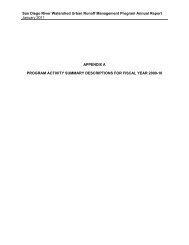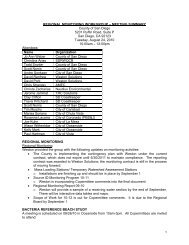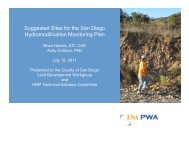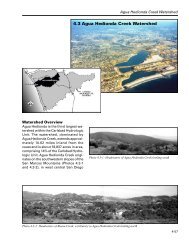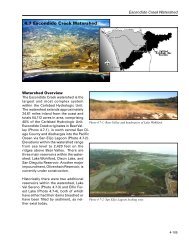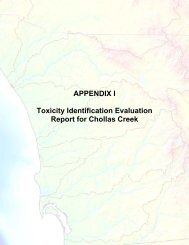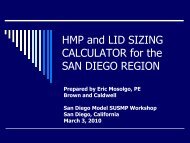APPENDIX I Toxicity Identification Evaluation Reports for Chollas ...
APPENDIX I Toxicity Identification Evaluation Reports for Chollas ...
APPENDIX I Toxicity Identification Evaluation Reports for Chollas ...
Create successful ePaper yourself
Turn your PDF publications into a flip-book with our unique Google optimized e-Paper software.
<strong>Toxicity</strong> <strong>Identification</strong> <strong>Evaluation</strong> of Sweetwater<br />
River Stormwater Using Selenastrum<br />
capricornutum August 2006<br />
dissolved inorganic salt (e.g., sodium, calcium, magnesium), or a cationic organic compound<br />
such as a cationic surfactant, because EDTA is a chelating agent that is well known to bind<br />
inorganic and organic cationic chemicals (USEPA 1991). Chemical analyses of Sweetwater<br />
stormwater samples demonstrated that TDS measured in the Sweetwater sample was 2640<br />
mg/L, a concentration that exceeds the water quality objectives <strong>for</strong> this measure, or 1500 mg/L,<br />
in the lower Sweetwater River (RWQCB 1994). In contrast, no organophosphate pesticides<br />
were detected in stormwater samples and the only metals detected were arsenic, nickel, and<br />
zinc, all of which were found at low concentrations, or concentrations far below water quality<br />
objectives. In addition, the causative agents of toxicity in the Sweetwater River stormwater<br />
samples did not share similar physicochemical properties to those of many other classes of<br />
chemicals. The lack of toxicity reduction in the SPE and PBO tests indicate that the causative<br />
agent was likely not a non-polar organic, or a common-use pesticide, respectively.<br />
It is well known that elevated concentrations of ions comprising the TDS may be toxic to aquatic<br />
organisms. Thus, the results of this TIE provide some evidence that the causative agent of<br />
toxicity may have been due to elevated TDS levels in the Sweetwater River sample collected in<br />
October 18, 2005. No additional toxicity was found in Sweetwater River samples in subsequent<br />
standard S. capricornutum tests during the 2005-2006 monitoring period, indicating that the<br />
causative agent was not persistent during this monitoring period. Additional studies would be<br />
necessary to confirm whether elevated TDS in Sweetwater River water were the causative<br />
agent of toxicity to S. capricornutum.<br />
Weston Solutions, Inc. 2







